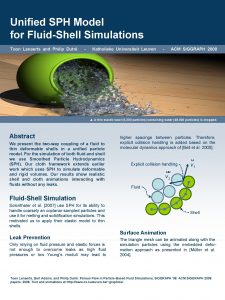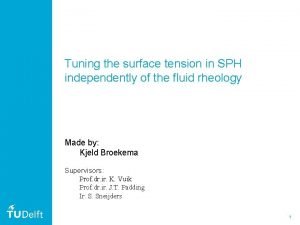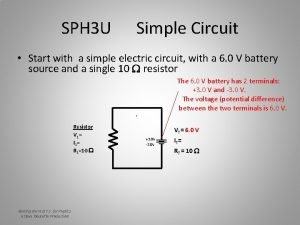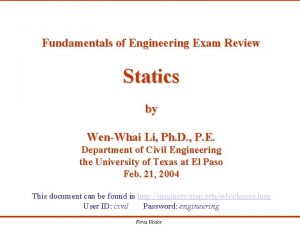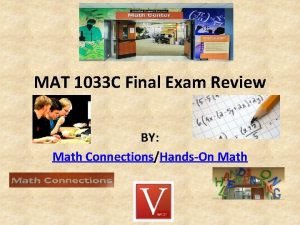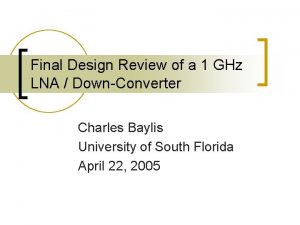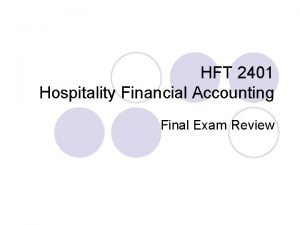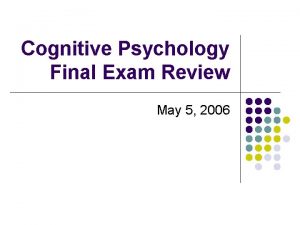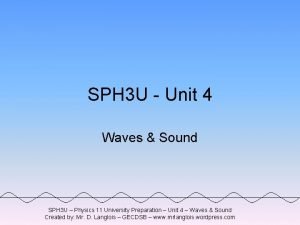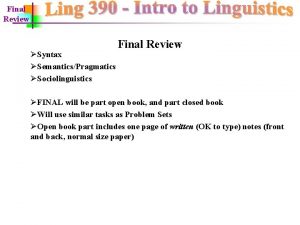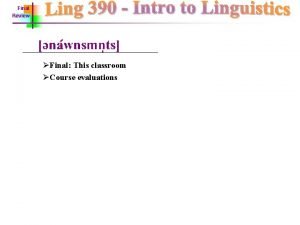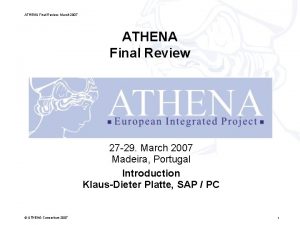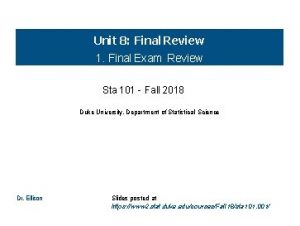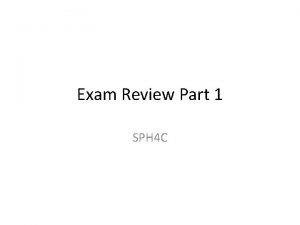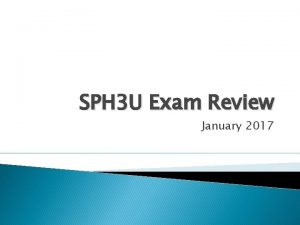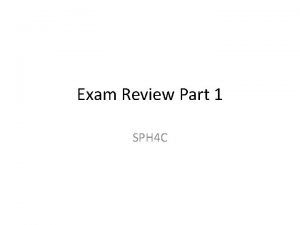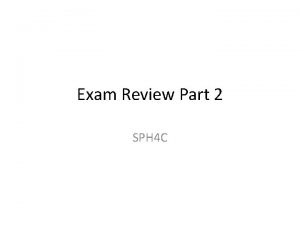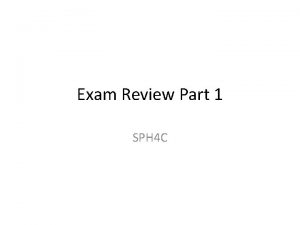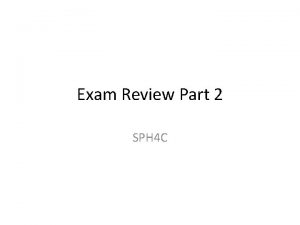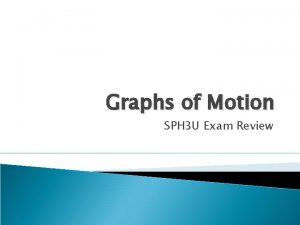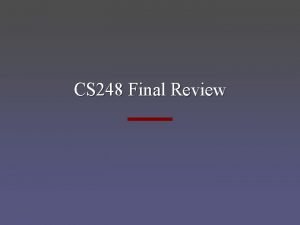SPH 4 U REVIEW SPH 4 U Final





![74 m/s 2 [E 26 o N] Newton in 2 -D Three dogs pull 74 m/s 2 [E 26 o N] Newton in 2 -D Three dogs pull](https://slidetodoc.com/presentation_image/3d71cf37c51736eb0f7000608923132d/image-6.jpg)









![p = 6. 4 kgm/s [N] Linear Momentum What is the momentum of a p = 6. 4 kgm/s [N] Linear Momentum What is the momentum of a](https://slidetodoc.com/presentation_image/3d71cf37c51736eb0f7000608923132d/image-16.jpg)
![J = 5. 69 kgm/s [up] Impulse A 0. 430 kg ball strikes the J = 5. 69 kgm/s [up] Impulse A 0. 430 kg ball strikes the](https://slidetodoc.com/presentation_image/3d71cf37c51736eb0f7000608923132d/image-17.jpg)

![v 2’ = 21 m/s [W 53 o S] Conservation of Momentum in 2 v 2’ = 21 m/s [W 53 o S] Conservation of Momentum in 2](https://slidetodoc.com/presentation_image/3d71cf37c51736eb0f7000608923132d/image-19.jpg)


















![B = 0. 28 T [N / up] Charged Particles in Magnetic Fields A B = 0. 28 T [N / up] Charged Particles in Magnetic Fields A](https://slidetodoc.com/presentation_image/3d71cf37c51736eb0f7000608923132d/image-38.jpg)




- Slides: 42

SPH 4 U REVIEW

SPH 4 U Final Exam Part 1: Knowledge & Understanding (Multiple Choice), 30 Marks Part 2: Application (Calculations), 40 Marks, approximately 1 question per unit Part 3: Communication, 20 Marks Part 4: Thinking & Inquiry, 20 Marks

Unit # 1: Dynamics Topics covered: Kinematics & Newton’s Laws Review Components and Projectile Motion Relative Motion Components & Projectiles Newton in 2 -D Inclined Planes String & Pulley Centripetal Motion – centripetal acceleration, tension in a string, centrifugal force, banked curves

1. 9 x 102 m Components & Projectiles A Euro 2016 player, kicks at soccer ball at an angle of 35 o above the horizontal, with an initial speed of 161 km/h. What is the range, if the ball lands at the same height?

Relative Motion A pilot wants to fly due east. Their airspeed is 225 km/ h, and the wind is 75 km/h [S 37 o E]. Determine the heading they must use. 71 m/s [E 15 o N]
![74 ms 2 E 26 o N Newton in 2 D Three dogs pull 74 m/s 2 [E 26 o N] Newton in 2 -D Three dogs pull](https://slidetodoc.com/presentation_image/3d71cf37c51736eb0f7000608923132d/image-6.jpg)
74 m/s 2 [E 26 o N] Newton in 2 -D Three dogs pull on a toy, with mass 0. 50 kg. The first dog pulls 25 N [N 30. 0 o. E]. The second dog pulls 12 N [S]. The third dog pulls 22 N [N 72 o. E]. Find the acceleration of the toy.

Newton in 2 -D A person pushes a lawnmower, with a force of 552 N. The handle makes an angle of 42. 0 o with the ground. If the lawnmower has a mass of 16. 5 kg, and the coefficient of friction between the lawnmower and the ground is 0. 15, determine the acceleration of the lawnmower. 20 m/s 2

2. 7 m/s 2 Inclined Planes A 35 kg box is on a ramp, as shown. If the coefficient of kinetic friction between the box and the ramp is 0. 12, determine the acceleration of the box. 23 o

2. 4 m/s 2, 74 N String & Pulley Two masses, m 1 and m 2, are attached to a string, which passes over a frictionless pulley. m 1 is 10. 00 kg and m 2 is 6. 00 kg. Calculate the tension in the string and the acceleration of the masses.

String & Pulley & Inclined Plane Two masses, m 1 and m 2, are attached to a string, which passes over a frictionless pulley, as shown in the diagram below. m 1 is 10. 00 kg and m 2 is 6. 00 kg. The coefficient of friction between the masses and the ramp is 0. 467. Calculate the tension in the string and the acceleration of the masses. m 1 m 2 50 o 35 o 1 m/s 2, 60 N

Tt = 1. 4 x 102 m; Tb = 1. 6 x 102 m Centripetal Motion A 1. 2 kg mass is twirled in a circle, on the end of a string of length 0. 80 m. The mass completes 2. 0 rotations per second. Determine the tension(s) in the string.

Banked Curve A driver enters a banked curve with a radius of 800. 0 m while travelling at a constant speed of 55. 6 m/s. Assume the surface is frictionless. Determine the angle of the banked curve. 22 o

Unit # 2: Energy & Momentum Topics covered: Work Kinetic Energy Gravitational Potential Energy Hooke’s Law Elastic Energy Total Energy; Conservation of Energy Linear Momentum Impulse Conservation of Linear Momentum in 1 -D and 2 -D Elastic and Inelastic Collisions Neutrino

W = 1900 J Work A newspaper carrier pulls a wagon with a force of 250 N at an angle of 45 o to the horizontal. Assuming no friction, how much work is required to move the wagon 11 m?

Conservation of Energy The bumper of a 2200 kg car on an amusement park ride has a spring constant of 5. 1 x 106 N/m. At a point in time, the car is moving 6. 7 m/s [forward], at a height of 5. 00 m. At the bottom of the hill, the car when it crashes into a solid wall. How much will the bumper be compressed when the car is travelling 3. 5 m/s? 0. 24 m
![p 6 4 kgms N Linear Momentum What is the momentum of a p = 6. 4 kgm/s [N] Linear Momentum What is the momentum of a](https://slidetodoc.com/presentation_image/3d71cf37c51736eb0f7000608923132d/image-16.jpg)
p = 6. 4 kgm/s [N] Linear Momentum What is the momentum of a heron, with a mass of 1. 2 kg, travelling 5. 3 m/s [N]?
![J 5 69 kgms up Impulse A 0 430 kg ball strikes the J = 5. 69 kgm/s [up] Impulse A 0. 430 kg ball strikes the](https://slidetodoc.com/presentation_image/3d71cf37c51736eb0f7000608923132d/image-17.jpg)
J = 5. 69 kgm/s [up] Impulse A 0. 430 kg ball strikes the ground with a velocity of 9. 00 m/s [down]. It rebounds with a velocity of 4. 23 m/s [up]. Determine the impulse of the ball.

v 2‘ = 6. 9 m/s Conservation of Momentum in 1 D A cue ball with mass (0. 17 kg) and velocity of 6. 4 m/s [forward] collides with a stationary pool ball with a mass of 0. 16 kg. Determine the velocity of the second pool ball, if the cue ball rebounds with a velocity of 0. 125 m/s [backward].
![v 2 21 ms W 53 o S Conservation of Momentum in 2 v 2’ = 21 m/s [W 53 o S] Conservation of Momentum in 2](https://slidetodoc.com/presentation_image/3d71cf37c51736eb0f7000608923132d/image-19.jpg)
v 2’ = 21 m/s [W 53 o S] Conservation of Momentum in 2 D A car, travelling 28 m/s [N], with mass = 1400 kg, has a glancing collision with a truck, mass 2300 kg, travelling 25 m/s [S]. If the car is deflected [N 55 o E] at 26 m/s, find the velocity of the truck.

Inelastic Elastic and Inelastic Collisions Two toy trains (m 1 = 0. 300 kg, m 2 = 0. 600 kg) collide on a straight section of a model rail track. Train 1 is travelling at 2. 5 m/s when it strikes train 2, which is at rest. After the collision, train 1 has a speed of -0. 7 m/s. Determine whether the collision is elastic or inelastic.

Unit # 3: Gravitational, Electric, Magnetic Fields Topics covered: Newton’s Law of Universal Gravitation Coulomb’s Law Electric Fields Electric Potential Charged Particles in Electric Fields Parallel Plates Millikan Magnetic Fields (Right Hand Rules) Magnetic Force; The Motor Principle Faraday’s Law Charged Particles in Magnetic Fields

7 x 104 m Newton’s Law of Universal Gravitation The force of attraction between the Earth and a satellite, of mass 400 kg, is 3830 N. Determine the distance between the satellite and the surface of the Earth.

T = 2. 3 x 106 s Orbits The Earth(m = 5. 98 x 1024 kg) and the Moon (m = 7. 35 x 1022 kg) are separated at their centres by a distance of 3. 8 x 108 m. Determine the period of the Moon’s rotation about Earth.

2. 1 N towards q 2 Coulomb’s Law Three point charges, q 1 = 3. 6 x 10 -6 C, q 2 = -2. 7 x 10 -6 C, q 3 = 4. 5 x 10 -6 C, are arranged on the xaxis. The distance between q 1 and q 2 is 30 cm, and the distance between q 2 and q 3 is 20 cm. Find the total force on q 3.

Electric Fields Draw the electric field created by the point charges below.

1 x 109 N/C, 1. 2 x 108 N/C, 1. 1 x 107 N/C Electric Fields A point charge of +3. 0 x 10 -6 C creates an electric field. What is the electric field strength 0. 5 cm away? 1. 5 cm away? 5. 0 cm away?

V = 16 V Electric Potential 2. 1 x 10 -5 J of work are done in moving a point charge, q = 1. 3 x 10 -6 C, against an electric field. Determine the potential difference between the initial and final positions.

Parallel Plates Draw the electric field around the parallel plates. + + - -

v = 6. 9 x 105 m/s Charged Particles in Electric Fields A set of parallel plates with a potential difference of 2. 5 x 103 V is used to accelerate a proton from rest into a magnetic field. Determine the velocity of the proton when it leaves the plates.

Magnetic Fields Draw the magnetic field around the objects below. N Earth S

Magnetic Fields A current-carrying wire

Magnetic Fields A solenoid

Magnetic Fields Force on a current-carrying wire in a magnetic field

3. 3 x 10 -5 T Magnetic Fields Find the strength of a magnetic field 1. 5 cm away from a straight conductor carrying a current of 2. 5 A.

5 x 10 -3 T Magnetic Fields Find the magnetic field strength of a solenoid that is 30 cm long with 1500 turns, carrying a current of 0. 75 A.

F = 60 N Magnetic Force A wire, carrying a current of 15 A is in a magnetic field of 2. 5 T, at an angle of 90 o, for a length of 1. 7 m. Determine the force on the wire.

4. 1 x 10 -4 N/m Magnetic Force Two wires are 1. 4 cm apart. Wire one is carrying a current of 3. 0 A, wire two is carrying a current of 9. 5 A. Find the force per unit length.
![B 0 28 T N up Charged Particles in Magnetic Fields A B = 0. 28 T [N / up] Charged Particles in Magnetic Fields A](https://slidetodoc.com/presentation_image/3d71cf37c51736eb0f7000608923132d/image-38.jpg)
B = 0. 28 T [N / up] Charged Particles in Magnetic Fields A proton enters a magnetic field with a velocity of 1. 0 x 106 m/s [down], and experiences a force of 4. 5 x 10 -14 N [right]. Determine the magnitude and direction of the magnetic field.

Unit # 4: The Wave Nature of Light Topics covered: Wave and Particle Nature of Light Wave Theory Types of Waves Electromagnetic Waves Universal Wave Equation Refraction; Snell’s Law Dispersion Polarization Thin-Film Interference

0. 15 m Universal Wave Equation Microwaves have a frequency of 2. 0 x 109 Hz. Determine the wavelength of a microwave.

13 o Snell’s Law Find the angle of refraction for light travelling from air (n = 1. 00) to diamond (n = 2. 42) if the angle of incidence is 32 o.

Bright: 1. 4 x 10 -7 m; Dark: 2. 9 x 10 -7 m Thin Lens Interference Light of wavelength 580 nm strikes a soap film, which is surrounded by air. What is the minimum thickness needed to produce a light spot? A dark spot?
 Ap gov review final exam review
Ap gov review final exam review Ohsu sph
Ohsu sph Sph saxion
Sph saxion Sph toons
Sph toons Sph 4 inches
Sph 4 inches Netgear sph
Netgear sph Sph surface tension
Sph surface tension Sph +3
Sph +3 Sph cah toa
Sph cah toa Definition of a circle in geometry
Definition of a circle in geometry World history first semester exam review
World history first semester exam review Spanish 2 final exam practice test
Spanish 2 final exam practice test Fe exam statics review
Fe exam statics review Mat1033 final exam
Mat1033 final exam Ap world history jeopardy review game
Ap world history jeopardy review game Human body systems final exam
Human body systems final exam Earth science final exam review
Earth science final exam review English 11 semester exam
English 11 semester exam Principles of business final exam answer key
Principles of business final exam answer key Personal finance final exam review
Personal finance final exam review Giles corey crucible
Giles corey crucible World history spring final exam review answers
World history spring final exam review answers Zoology semester 1 exam review answers
Zoology semester 1 exam review answers U.s. history semester 2 final exam
U.s. history semester 2 final exam Poe practice test answer key
Poe practice test answer key Apes semester 1 review
Apes semester 1 review Physics fall final exam review
Physics fall final exam review Spanish 2 review packet
Spanish 2 review packet Antigone multiple choice test
Antigone multiple choice test Final design review
Final design review Physical science final exam study guide
Physical science final exam study guide World history and geography final exam study guide
World history and geography final exam study guide Algebra 1 semester 2 final exam
Algebra 1 semester 2 final exam World history semester 2 final review packet
World history semester 2 final review packet Ied final exam review
Ied final exam review Us history semester 1 final exam study guide answers
Us history semester 1 final exam study guide answers Financial accounting final exam
Financial accounting final exam Final exam environmental science
Final exam environmental science Psyc 1504 final exam
Psyc 1504 final exam Spanish 1 semester 1 final exam answer key
Spanish 1 semester 1 final exam answer key Chemistry fall semester exam review answers
Chemistry fall semester exam review answers Narrative review vs systematic review
Narrative review vs systematic review Chapter review motion part a vocabulary review answer key
Chapter review motion part a vocabulary review answer key



